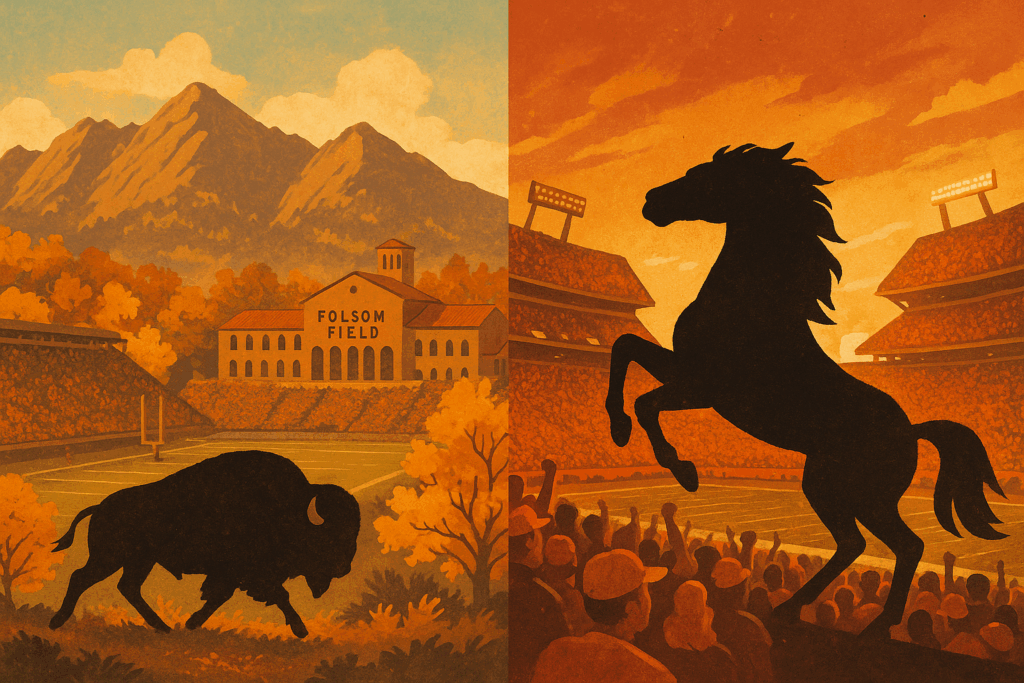Growing up in Colorado, I learned early that fall weekends are a two-act performance.
First comes Saturday in Boulder. Ralphie runs, Buffaloes Buffaloes Go CU (wink), Big Jim nearly fighting with opposing fans, and the best view in sports.
Then on Sunday, everything shifts to Denver. The South Stands, the Orange Crush, and the knock-off horse that runs after Broncos touchdowns. Mile High Stadium – it will always be Mile High Stadium – is a Sunday cacophony of hope, noise, and beer.
These are two of my favorite things.
Somewhere along the way, my dad developed a running theory. He believes the Buffs and the Broncos are locked in a karmic tug-of-war. One triumps, the other pays the price. A Buffs win means a Broncos loss. A Broncos win means a heartbreak in Boulder. It was the sort of theory you hear, laugh at, and somehow keep repeating. He believed it with the quiet confidence that only dads seem to have.
And after a couple of decades, I started to wonder – is my dad’s theory correct? If CU wins, does it doom the Broncos to a loss? Or vice versa?
So I decided to put my dad’s theory to the test.
Methodology
I used ChatGPT for some of the research — I’m a former corporate lawyer, not a mathematician! — and I had the poor AI working so hard I probably blew up a couple of data centers. My bad. As a result, I focused on the last 9 years of results (ChatGPT told me it was unable to go back further than that without getting permission from Sam Altman). For the Buffs, I used each regular-season game from 2016 through 2024. For the Broncos, I did the same, including Thursday night and Monday night matchups.
Then I paired each weekend where both teams played, and labeled the outcomes four ways:
- Both teams won
- Both teams lost
- CU win & Broncos loss
- CU loss & Broncos win
From there, I tallied the results and ran a chi-square test to see if the pattern was just coincidence or something more meaningful.
Dad, I did it. I put your theory up against the data.
The Results
Once the weekends were paired and the numbers laid out, the pattern looked a lot like… well, sports. Over the nine seasons from 2016 to 2024, the Buffaloes and Broncos played on the same weekend 89 times. Here’s how those weekends broke down:
- Both teams won: These are good weekends, friends. This happened in 13/89 games, or 14.6% of the time.
- Both teams lost: Tough times build character. 29/89 games, or 32.6% of the time.
- One wins, the other loses: The largest category — not by a landslide, but enough to notice. CU win & Denver loss: 21/89 games, or 23.6% of the time. Denver wins & CU loses: 26/89 games, or 29.2% of the time.
My dad’s theory is right about 54% of the time. In other words, inverse outcomes (one team wins while the other team loses) occurred 47 times, representing about 54% of the pairings.
So what does that mean? The link between teams came back as not statistically significant. Here’s how ChatGPT wrote the test result:
“I assembled a 2×2 contingency table of CU and Denver win/loss results and performed a chi‑square test of independence. The chi‑square statistic (with Yates’ continuity correction) was ≈ 0.38 with a p‑value ≈ 0.54, meaning there is no statistically significant relationship between CU and Denver results over 2016–2024.”
In human terms, the ups and downs of CU and the Broncos have little to do with each other. Shockingly, team success seems more tied to Sean Payton or Karl Dorrell than a half-baked theory. They rise and fall on their own, not as opposite sides of some Rocky Mountain karmic balance scale.
I can hear my dad, though. He’d want me to know that the 54% pairing percentage is still slightly above the 50% random split.
And here is something that my dad would appreciate. The pattern did spike in certain seasons — especially in 2023. In 2023, both lost twice in the same weekend. CU won, and Denver lost, 3 times in the same weekend. CU lost, and Denver won, 5 times in the same weekend. This means that there were inverse outcomes (one wins, the other loses) in 8 of 10 games, or in 80% of the teams’ games! My dad’s theory can hang its hat on 2023.
When I finally stepped back from the numbers, however, I that the point was never really about whether the theory was statistically true. What mattered was that it felt true. My dad’s theory gave shape to the emotional rhythm of fall in Colorado. It was a way of making sense of the wild mood swings of fandom, of tethering two teams and two places and two days into a single shared experience.
My dad’s theory wasn’t science. It was storytelling.
And there’s something quietly beautiful about how these little myths get passed along. You hear them at tailgates, on back porches, in the passenger seat on the long drive home. You inherit them and hold them.
And one day, you find yourself telling your own kids that the success of the Buffs and Broncos are inversely linked together. And maybe, just maybe, they start to believe it.
Want to read more from BuffsBlog? Check out this story discussing how to emerge out of the mess that was the CU vs. Arizona football game:

Bravo.
Effin A Cotton, effin A.
Pingback: CU Football Now Looking to the Future - BuffsBlog.com